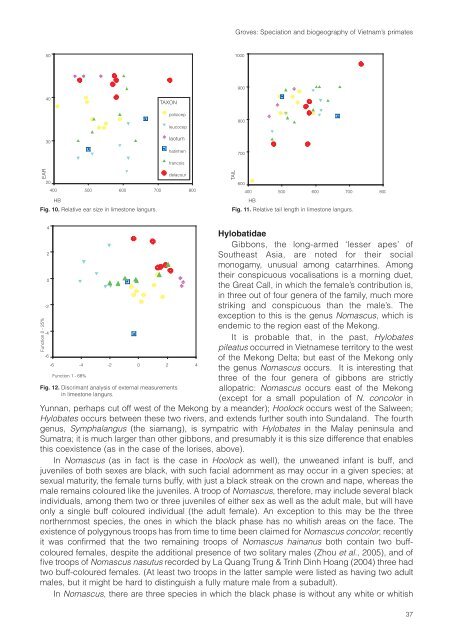Vietnamese Journal of Primatology - Frankfurt Zoological Society
Vietnamese Journal of Primatology - Frankfurt Zoological Society
Vietnamese Journal of Primatology - Frankfurt Zoological Society
You also want an ePaper? Increase the reach of your titles
YUMPU automatically turns print PDFs into web optimized ePapers that Google loves.
40<br />
30<br />
20<br />
EAR 50<br />
400<br />
HB<br />
500<br />
600<br />
700<br />
TAXON<br />
poliocep<br />
leucocep<br />
laotum<br />
hatinhen<br />
francois<br />
delacour<br />
800<br />
Groves: Speciation and biogeography <strong>of</strong> Vietnam’s primates<br />
Fig. 10. Relative ear size in limestone langurs. Fig. 11. Relative tail length in limestone langurs.<br />
Function 2 - 25%<br />
4<br />
2<br />
0<br />
-2<br />
-4<br />
-6<br />
-6<br />
-4<br />
Function 1 - 68%<br />
-2<br />
Fig. 12. Discrimant analysis <strong>of</strong> external measurements<br />
in limestone langurs.<br />
0<br />
2<br />
4<br />
Hylobatidae<br />
Gibbons, the long-armed ‘lesser apes’ <strong>of</strong><br />
Southeast Asia, are noted for their social<br />
monogamy, unusual among catarrhines. Among<br />
their conspicuous vocalisations is a morning duet,<br />
the Great Call, in which the female’s contribution is,<br />
in three out <strong>of</strong> four genera <strong>of</strong> the family, much more<br />
striking and conspicuous than the male’s. The<br />
exception to this is the genus Nomascus, which is<br />
endemic to the region east <strong>of</strong> the Mekong.<br />
It is probable that, in the past, Hylobates<br />
pileatus occurred in <strong>Vietnamese</strong> territory to the west<br />
<strong>of</strong> the Mekong Delta; but east <strong>of</strong> the Mekong only<br />
the genus Nomascus occurs. It is interesting that<br />
three <strong>of</strong> the four genera <strong>of</strong> gibbons are strictly<br />
allopatric: Nomascus occurs east <strong>of</strong> the Mekong<br />
(except for a small population <strong>of</strong> N. concolor in<br />
Yunnan, perhaps cut <strong>of</strong>f west <strong>of</strong> the Mekong by a meander); Hoolock occurs west <strong>of</strong> the Salween;<br />
Hylobates occurs between these two rivers, and extends further south into Sundaland. The fourth<br />
genus, Symphalangus (the siamang), is sympatric with Hylobates in the Malay peninsula and<br />
Sumatra; it is much larger than other gibbons, and presumably it is this size difference that enables<br />
this coexistence (as in the case <strong>of</strong> the lorises, above).<br />
In Nomascus (as in fact is the case in Hoolock as well), the unweaned infant is buff, and<br />
juveniles <strong>of</strong> both sexes are black, with such facial adornment as may occur in a given species; at<br />
sexual maturity, the female turns buffy, with just a black streak on the crown and nape, whereas the<br />
male remains coloured like the juveniles. A troop <strong>of</strong> Nomascus, therefore, may include several black<br />
individuals, among them two or three juveniles <strong>of</strong> either sex as well as the adult male, but will have<br />
only a single buff coloured individual (the adult female). An exception to this may be the three<br />
northernmost species, the ones in which the black phase has no whitish areas on the face. The<br />
existence <strong>of</strong> polygynous troops has from time to time been claimed for Nomascus concolor; recently<br />
it was confirmed that the two remaining troops <strong>of</strong> Nomascus hainanus both contain two buffcoloured<br />
females, despite the additional presence <strong>of</strong> two solitary males (Zhou et al., 2005), and <strong>of</strong><br />
five troops <strong>of</strong> Nomascus nasutus recorded by La Quang Trung & Trinh Dinh Hoang (2004) three had<br />
two buff-coloured females. (At least two troops in the latter sample were listed as having two adult<br />
males, but it might be hard to distinguish a fully mature male from a subadult).<br />
In Nomascus, there are three species in which the black phase is without any white or whitish<br />
900<br />
800<br />
700<br />
600<br />
TAIL 1000<br />
400<br />
HB<br />
500<br />
600<br />
700<br />
800<br />
37
















